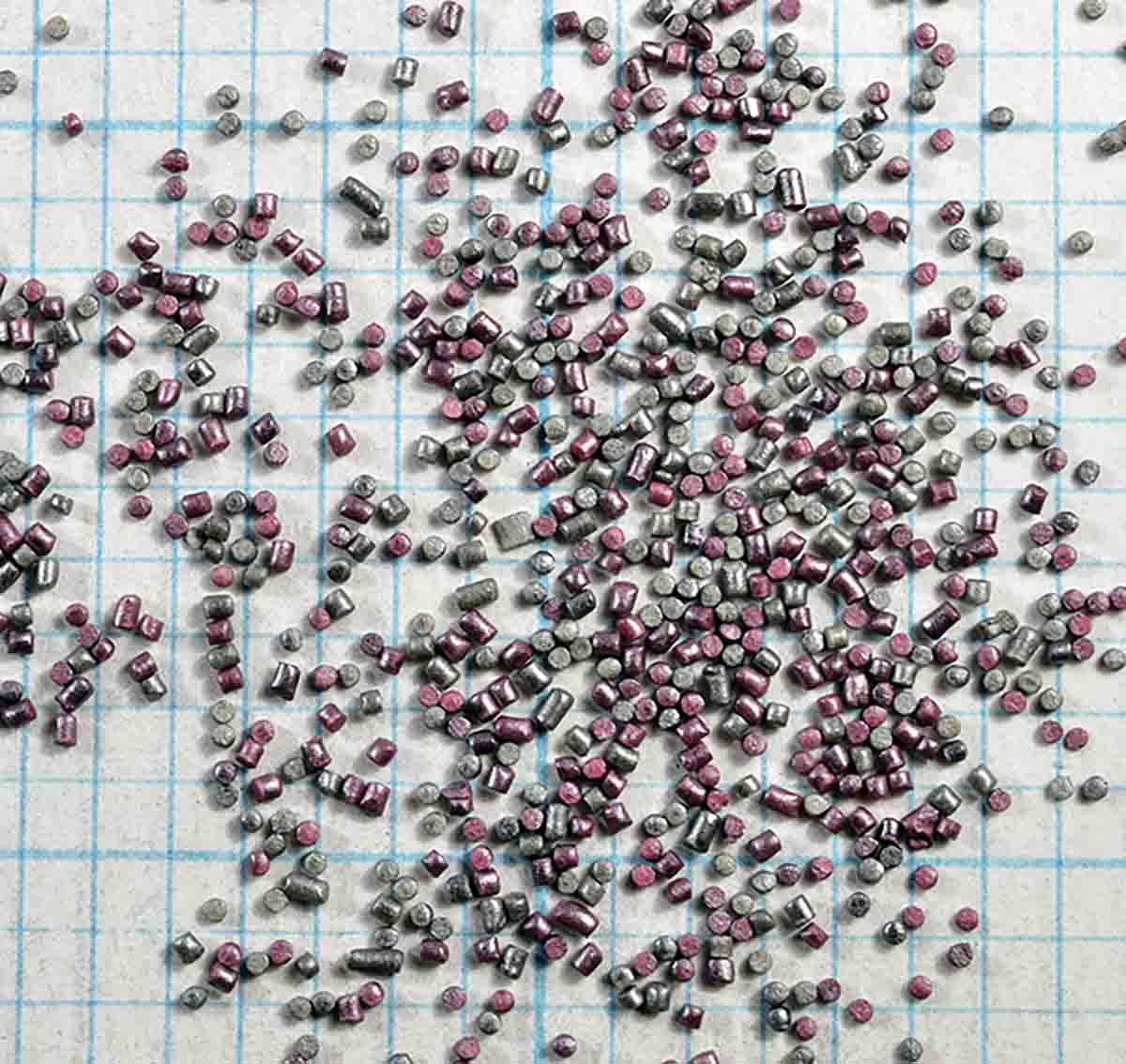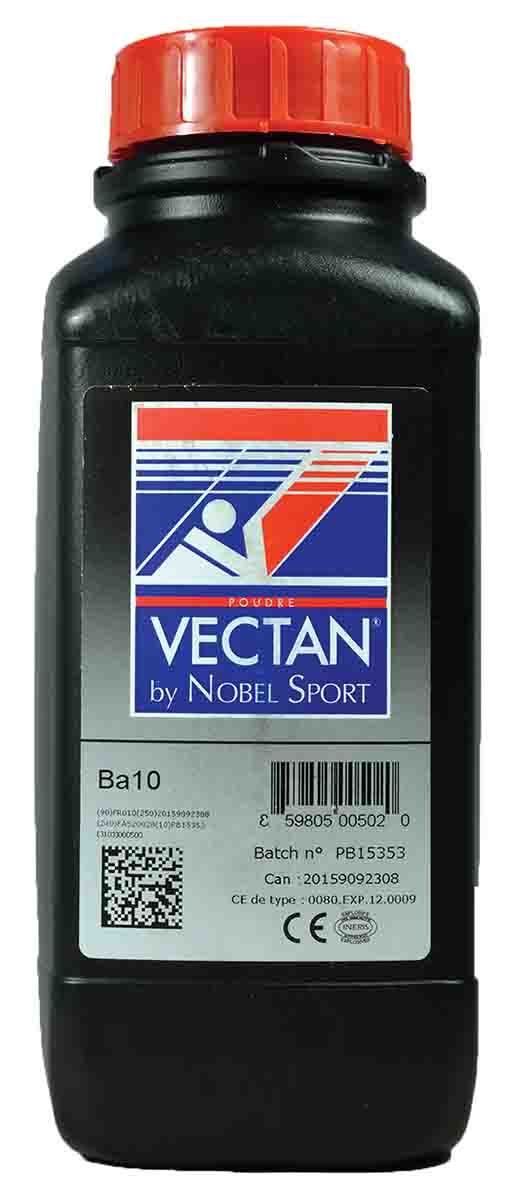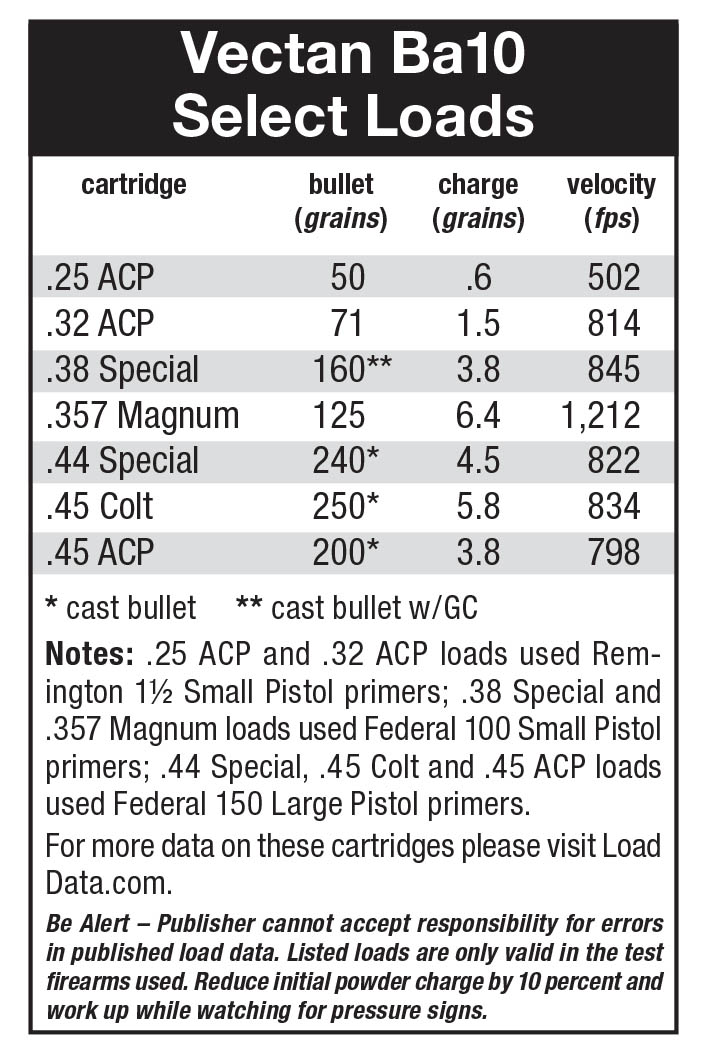Propellant Profiles
Vectan Ba10
column By: R.H. Vandenburg, Jr. | December, 18
I have previously only had the opportunity to examine one Vectan powder, Vectan AS, which is useful in a wide range of handgun cartridges as well as 12- and 16-gauge shotshells. This time a purely handgun powder is reviewed: Ba10.
As some handloaders may remember, Vectan powders are imported from France. A part of the French conglomerate Societe Nationale des Poudres et Explosifs (SNPE), which includes NobelSport and Martignoni, Vectan

Martignoni produces primers under its own name as well as that of NobelSport. NobelSport produces factory shotshells using Vectan powders, Martignoni primers and its own shells and wads. NobelSport shotshells on
hand were assembled in Italy. NobelSport recently has begun to offer a series of 12-gauge plastic wads for ¾, 7⁄8, 1 and 11⁄8 ounces of lead shot. Other, principally British and European, shotshell companies such as Gamebore frequently use Vectan powders in their shotshells.
There are 19 powders in the Vectan line currently being imported – of which I have 18. Half are suited for reloading shotshells. There are five listed as exclusively handgun powders: Ba10, Ba9½, Ba9, Ba7½ and Ba6½, from fastest to slowest. All are single base, meaning they contain no nitroglycerin and, oddly, are of stick or tubular form. This latter is quite unusual as American handgun powders are exclusively flake or spherical in form. The U.S. importer of the Vectan powder line is Graf & Sons of Mexico, Missouri. Other sources are becoming available as well, such as Ballistic Products, Inc. of Corcoran, Minnesota.

My first effort was with the .25 ACP. It was also my first surprise. The maximum powder charge of Ba10 with a 50-grain bullet is .6 grain – that’s .6 grain! I have three powder measures specifically designed to accurately and consistently dispense small amounts of powder for small-capacity handgun cartridges. Heretofore, my goal was one grain, which all three measures will comfortably dispense with any appropriate powder. None of them could be adjusted to throw .6 grain. All bottomed out at about .9 grain. Consequently, I had to weigh each charge. This is not a problem when loading a small number of cases, but it would be if endeavoring to load a large number. So, perhaps Ba10 is not the best match for this cartridge. Velocity was not the

For the .32 ACP I worked with a Remington 71-grain FMJ bullet, although the published Vectan data called for a bullet of 77 grains. Recorded velocity slightly exceeded that published and, once again, functioning was flawless.
With the .38 Special, selected was a cast bullet from RCBS 38-160-GC mould that weighed 162 grains lubed and with a gas check. This was a very good combination, and groups were satisfyingly small. From a 4-inch barrel, velocities did not match those published from a 6-inch barrel, but extreme spreads were very low.
The .357 Magnum data limited Ba10 to lightweight bullets. A Winchester 125-grain HP provided pleasing results. Normally I choose heavier bullets for use in this cartridge, and will again when using slower powders.
Both the .45 Colt and .45 ACP published data used cast bullets, so I followed suit. In the .45 Colt, I used a Meister Bullets’ 250-grain SWC. Ba10 performed very well, providing small groups and extreme spreads. Adjusting for differences in barrel length – mine was .75-inch shorter – velocity was spot on. As a .45 Colt target or general purpose carry load, Ba10 shined.
In the .45 ACP, Ba10 was listed with all weights from 185 to 230 grains with both cast and jacketed bullets. Still thinking target powder, a perennial favorite was chosen, a 200-grain SWC from Lyman mould No. 452460. These have served me well for many years. Much like my experience with the .45 Colt, Ba10 again provided small groups and extreme spreads, and single digit standard deviations. Ejected cases fell nearby, and near to each other.
After completing the above shooting, another Vectan powder source turned up data for the .41 Magnum, .44 Russian, .44-40 Winchester, .44 Special and .44 Magnum, all with cast bullets. Running short on time, I added the .44 Special with a 240-grain SWC from a long forgotten commercial source. The results mirrored those of the .45 Colt and .45 ACP.
All in all, Vectan Ba10 performed quite well throughout its range. It, along with the other Vectan powders, is packaged in .500 kg containers. That’s 1.1 pounds to you and me.


